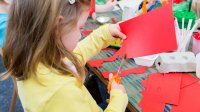Executive Functioning and Kindergarten Readiness
Preschool teachers can use these strategies with students this fall and throughout the year to promote the skills they’ll need in kindergarten.
Your content has been saved!
Go to My Saved Content.As we prepare to welcome our youngest learners to classrooms this fall, preschool and early childhood teachers are likely wondering how to best prepare children with the skills necessary to be kindergarten ready. Given that many preschool-aged children weren’t in formal in-person learning programs last year, building the academic and executive functioning skills they need for kindergarten is especially important for this incoming cohort of students.
Executive functioning skills include organizing and prioritizing, staying focused on tasks, and regulating emotions. Children begin developing executive functioning skills rapidly between the ages of 3 and 5. Preschool and early childhood teachers play an important role in helping young learners develop academic skills (such as recognizing letters, colors, and numbers) and developing the executive functioning skills they need to be prepared for kindergarten.
Below are a few executive function strategies that early childhood teachers can use to start the school year and adapt to use throughout the year as students demonstrate mastery.
Kid-Built Flexible Schedules
Using sticky notes or premade visuals, help students create a flexible schedule for the day or learning block. Ideally, each student should build their own schedule by selecting two or three activities or skills from a list. It may help to think of these as “learning centers” that students might move through in a classroom; however, in this instance, each child decides which activity or skill they want to work on first, next, and last. For example, they may choose to first practice writing their name, next to work on a tangram puzzle, and last to practice cutting shapes using scissors.
As the school year progresses, and depending on the progress of each student, you can change the activities on the list. For example, students who are already able to identify all of their uppercase letters might be given the task of matching upper and lowercase letters as one of their schedule options.
Student-built schedules are an age-appropriate way to give young learners autonomy and model executive functioning skills like organizing, planning, and prioritizing.
Visual Timers
Working with my preschool-aged son as he learned how to write his name, I quickly realized that his frustration tolerance for handwriting was quite low, and he would often abandon the task. We tried using a visual timer that allowed him to allocate time for the activity and see how much time was left.
Children may get frustrated practicing handwriting or fine-motor skills for 15 minutes, so encourage them to set the timer for 5 minutes, check in with how they’re doing, and encourage them to take breaks, if necessary. This helps model time management and executive functioning skills like self-monitoring and paying attention/maintaining focus. Using visual countdown timers or sand timers also can help children develop the ability to self-monitor and maintain the focus they need for task completion.
Moreover, allowing students to choose how much time they’ll allocate for an activity—in 5- or 10-minute increments—allows them to manage aspects of their environment and feel empowered in their learning.
Story of Your Day
Young children love not only listening to stories, but telling their own stories by stringing together different events. Toward the end of the day or learning block, have students tell the story of their day by drawing pictures or arranging premade visuals of different classroom activities. Direct students to revisit their flexible schedule and create a simple story using a First, Next, Last graphic organizer, for example.
Students can take turns sharing their stories with classmates during a closing circle and getting excited about what they want to do the next day. Telling the story of their day will help students practice sequencing and also develop executive functioning skills associated with working memory, which allows them to practice mentally holding and manipulating information.
Daily Reflection Protocol
Helping young children learn how to regulate their emotions is a core competency of early childhood educators and supports young learners as they build executive functioning and academic skills. “Research indicates that children who are mentally healthy tend to be happier, show greater motivation to learn, [and] have a more positive attitude toward school,” according to professors Jeannie Ho and Suzanne Funk.
Adjusting to a new school year, especially after the last school year was disrupted by the pandemic, is likely to bring with it a range of emotions for preschoolers. Teachers can help by working with students to name various emotions they may be feeling, particularly during different times of the school day, and engaging them in daily reflection. Does a particular student feel happy working on a puzzle but frustrated or angry while practicing sight words?
Invite students to select emojis or pictures from an emotions chart that describe how they felt during different activities on their kid-built schedule. Have them identify something that was challenging, something they’re proud of, and something they want to work on the following day. Engaging students in this type of daily reflection will help lay the groundwork they need to regulate their emotions during activities.
Once you introduce students to each of these strategies, you can build them into a daily routine and tweak them as students become more adept at each of the skills.
